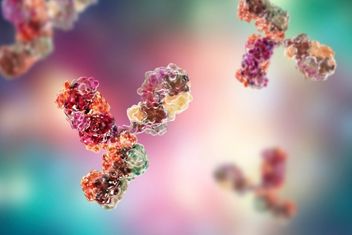Immunoprecipitation
Immunoprecipitation (IP) is a technique used to enrich protein antigens from a complex mixture using specific antibodies. To carry out an IP, antibodies must be coupled to a solid substrate, such as agarose resin or magnetic beads, to allow for purification of the target antigens.
Once an immunoprecipitation has been carried out successfully, additional methodologies - such as western blotting - can be used to quantify the amount of detected protein.
How Does Immunoprecipitation Work?
The principle of immunoprecipitation relies on the recognition of a target protein antigen by a specific antibody. In order for the antibody-protein complex to precipitate out of solution, it must be bound to a solid-state material. This can be done in one of two ways: either the antibody is bound to agarose or magnetic beads linked to protein A or G and then added to the protein-containing solution, or free antibody is added to the solution containing the target protein and the antibody-protein complex is subsequently bound to beads.
Regardless of the method chosen to target the protein of interest, the technique used for the precipitation is a function of the type of beads used. If magnetic beads are used, the tube containing the sample mixture can be placed in a magnetic chamber to capture the immunoprecipitate, and the unbound proteins can be washed away while the target protein remains. If agarose beads are used, the sample can be centrifuged to pellet the beads bound to the target protein, washed, and the supernatant discarded.
Why Choose Immunoprecipitation?
IP can be used as the first step in larger experiments that require isolating individual proteins or protein-containing complexes. When the goal is to isolate individual proteins, IP can be used for small-scale protein purifications, such as isolating a target protein produced by genetically engineered cells. It can also be used to enrich the concentration of a protein target that may be found in low abundance in the primary solution.
Proteins immunoprecipitated out of solution can be further analyzed for their molecular weight or post-translational modifications by using techniques such as western blotting or mass spectrometry. Protein-protein interactions can be characterized using co-IP or RIME (rapid immunoprecipitation mass spectrometry of endogenous proteins) which use IP followed by western blotting or mass spectrometry to identify characteristics of two or more complexed proteins.
Besides its utility in isolating proteins and protein complexes, techniques including ChIP, ChIP-seq, and RIP (RNA immunoprecipitation) can be used to map the nucleotide binding capacity of certain proteins in biologic samples. Additionally, IP can play a crucial role in yeast two-hybrid assays, since it can be used as a secondary method to control for the specificity of the technique.

Protocols
Get the most out of your immunoprecipitation testing with these methodologies:
- Immunoprecipitation Protocol
- Immunoprecipitation with Agarose-immobilized Antibody
- Preparation of Cell Lysate used for Immunoprecipitation
Related Applications
Immunoprecipitation FAQs
When probing immunoprecipitated samples on a western blot, the concentration of primary antibody can be increased resulting in an increase in sensitivity. However, for best results, the optimal dilution of antibody should be empirically determined.
The IP reaction should only be spun at a speed of 200 x g to 500 x g (maximum 2400 rpm in a microfuge). Spinning at higher speeds will result in rupture of the protein A/G beads and a pellet will not form.
Inhibitors are not necessary for the wash steps.
For best results, the optimal amounts of antibody should be empirically determined. But a general rule is to add 2 to 10 micrograms of antibody per 500 micrograms of lysate. If you are using neat antisera, or an IgG fraction (such as protein-A purified antibody), greater amounts of antibody are likely to be required.
By clicking “Acknowledge”, you consent to our website's use of cookies to give you the most relevant experience by remembering your preferences and to analyze our website traffic.
